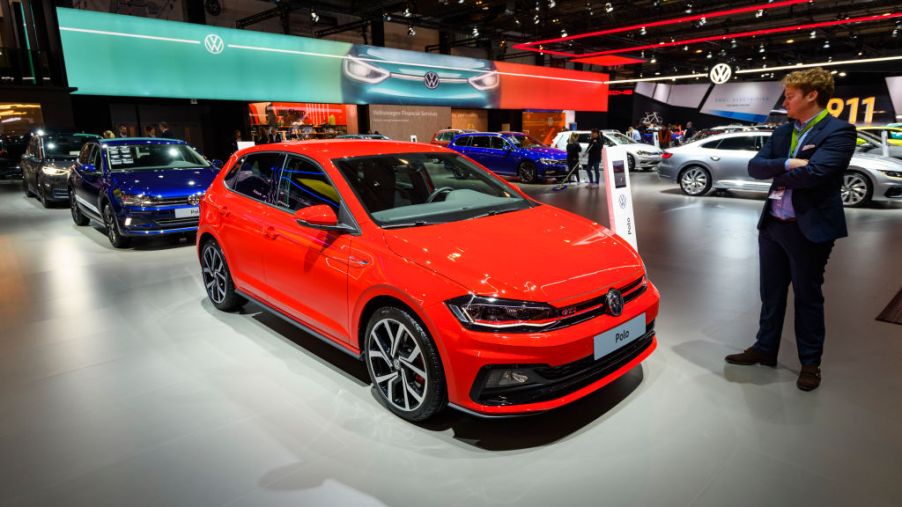
2020 Honda Fit or Volkswagen GTI: Which Hatchback Should You Buy?
Sometimes, all you need is a little car that’s fun to drive and gets good fuel economy. The 2020 Honda Fit and 2020 Volkswagen GTI are two of the top hatchback options to pick from. Here’s a look at how they stack up against each other.
Where the Honda Fit and Volkswagen GTI rank
U.S. News ranks the 2020 Honda Fit No. 1 in subcompact cars as well as No. 1 in hatchbacks and No. 1 in small cars. It ranks the VW GTI No. 1 in compact cars, No. 2 in hatchbacks, and No. 2 in small cars. The Fit earned an overall score of 8.7 out of 10, while the GTI earned an overall score of 8.6 out of 10.
The 2020 Honda Fit won U.S. News’ 2020 Best Subcompact Car for the Money award. This is the sixth year in a row that the Fit has won this award, reflecting its combination of quality with value.
Can the Honda Fit keep up with the Volkswagen GTI?
The Honda Fit does have a few negatives, though, and U.S. News mentions that it has “lackluster acceleration,” and its “engine drones at highway speeds.” The Fit’s engine is a 1.5-liter four-cylinder, with either a six-speed manual or a continuously variable automatic transmission (CVT). When paired with the manual transmission, the engine generates 130 hp and 114 lb-ft of torque. When paired with the CVT, the engine produces 128 hp and 113 lb-ft of torque. Neither transmission is able to create speedy acceleration.
The Volkswagen GTI’s engine is a turbocharged four-cylinder generating 228 hp – enough to give it good acceleration and handling. The six-speed manual transmission is standard, but a seven-speed dual-clutch automatic transmission is available.
Fuel economy
The Honda Fit has excellent fuel economy. With the CVT, the 2020 Honda Fit is rated for 33 mpg in the city and 40 mpg on the highway for a combined 36 mpg. With the manual transmission, it should get 29 mpg city and 36 mpg highway for 31 mpg combined.
U.S. News describes the CVT fuel economy as “phenomenal figures for a subcompact car.” The Volkswagen GTI is less fuel-efficient than its competitors, getting 24 mpg in the city, 32 mpg on the highway, and 27 mpg combined with both transmissions.
Comparing the interiors
Both the Honda Fit and the Volkswagen GTI seat five passengers and have plenty of head- and legroom. They both have lots of space and nice finishes. The Fit easily handles cargo since the rear seat can be reconfigured, allowing for the rear seat cushions to flip up to accommodate tall objects.
In addition, the front passenger seat is able to fold down flat. It features 16.6 cubic feet of cargo space. With the rear seat folded down, the cargo space is 52.7 cubic feet. The VW GTI has a lot of cargo space, with 22.8 cubic feet and 52.7 cubic feet with the rear seats folded down.
Technology
Both cars have good infotainment systems, though not the largest screens. The 2020 Honda Fit comes standard with a 5-inch infotainment screen, and a 7-inch touchscreen that’s compatible with Apple CarPlay and Android Auto is available. Other available tech in the Fit includes a navigation system, six-speaker stereo, HD Radio, satellite radio, and HondaLink.
The 2020 Volkswagen GTI has an easy-to-use 6.5-inch touchscreen infotainment system that is compatible with Apple CarPlay, Android Auto, and MirrorLink. It features a six-speaker audio system, a Wi-Fi hotspot, and the VW Car-Net App-Connect. An 8-inch touchscreen is available.
Safety and driver-assistance features
Both cars also have strong safety ratings. The NHTSA gave the 2020 Honda Fit an overall safety rating of five out of five stars. The IIHS gave its highest score of “Good” in four crash tests. It did give “Poor” and “Marginal” ratings for the standard and optional headlights, though.
The Fit’s only advanced and standard safety feature is a rearview camera. It offers a number of available driver-assistance features, including high-beam headlights and the Honda Sensing suite of features that includes forward-collision warning, automatic emergency braking, lane departure warning, and lane-keep assistance. Honda LaneWatch is also available to show a video of the passenger-side blind spot when the right-hand turn signal is turned on.
The Volkswagen GTI has good safety ratings too, earning five out of five stars overall from the NHTSA. It earned a 2019 Top Safety Pick from the IIHS. The GTI’s standard safety features and driver-assistance features include a rearview camera along with forward-collision warning, pedestrian detection, automatic emergency braking, blind-spot monitoring, and rear cross-traffic alert. It has the additional available features of front and rear parking sensors, parallel and perpendicular park assist, adaptive cruise control, and lane-keep assist.
The Honda Fit and Volkswagen GTI are similar hatchbacks, though the Fit is less expensive, six inches smaller in length, and has better fuel economy. The 2020 Volkswagen GTI has a starting price of $28,595, which is quite a bit more than the 2020 Honda Fit’s starting price of $16,190.
However, while the GTI is more expensive than its competitors, it does come with lots of features and value. It offers a sportier driving experience and more cargo space with the rear seats up. Both hatchbacks are a winner for the right buyer.


